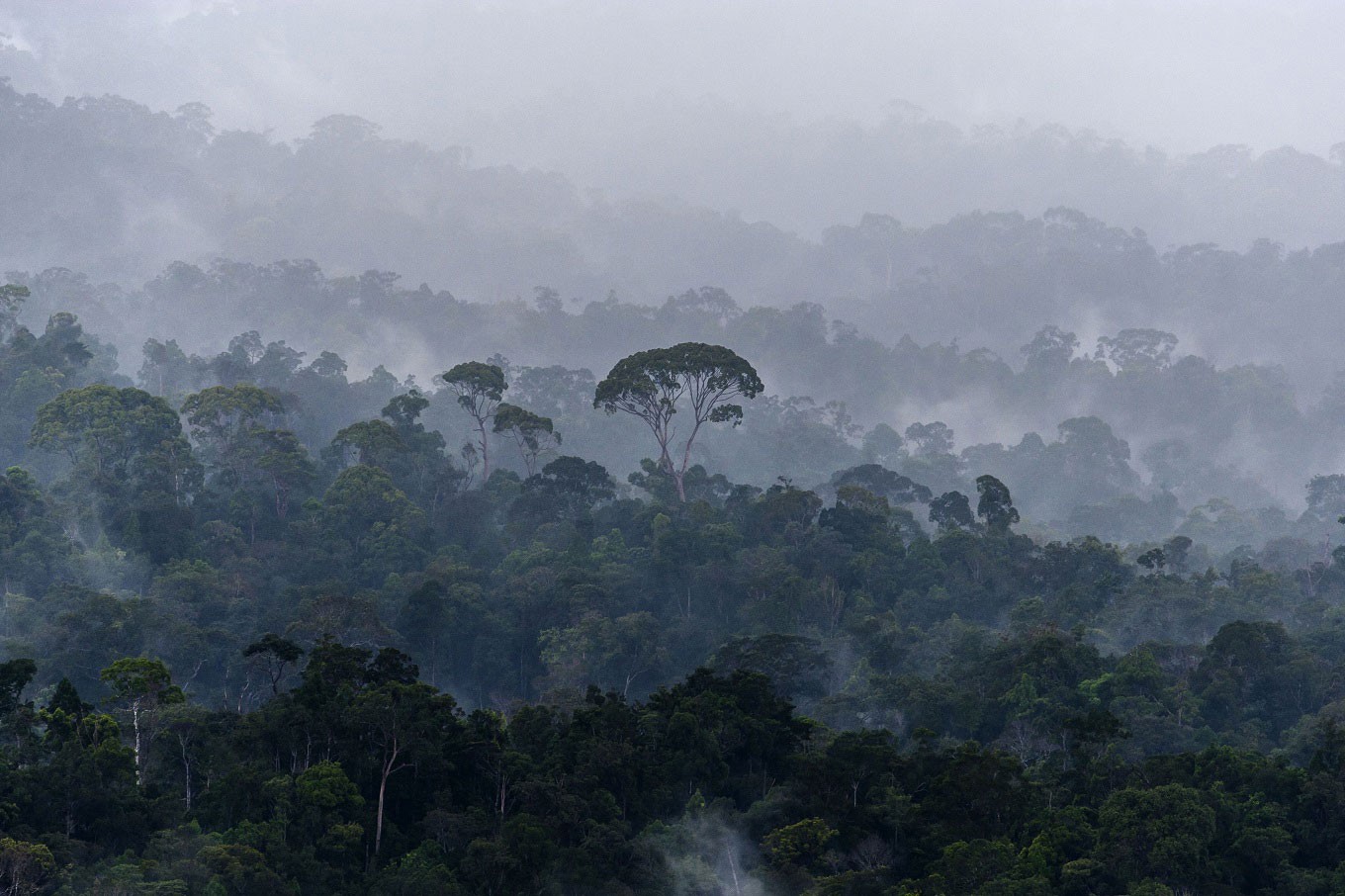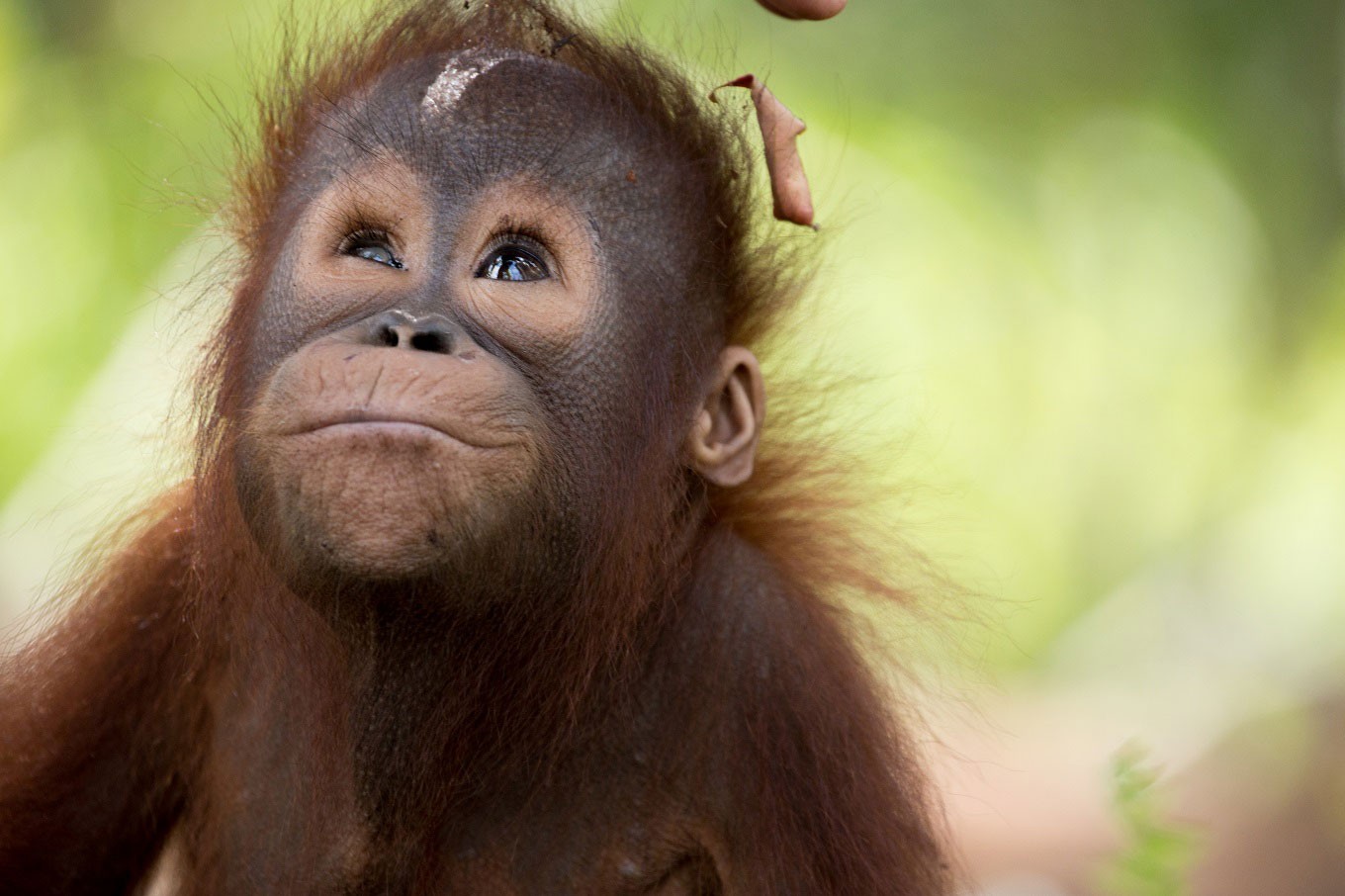Popular Reads
Top Results
Can't find what you're looking for?
View all search resultsPopular Reads
Top Results
Can't find what you're looking for?
View all search results'I am the Forest' exhibition reveals Kalimantan's magnificent wildlife
This is “I am the Forest”, a photo exhibition set up in the middle of a forest area in Rungan Sari, near Palangkaraya, Central Kalimantan. I was there to participate in the opening of the Global Issues Network environmental youth conference attended by 300 students and workshop facilitators from Kalimantan, Jakarta, Bali, Singapore, Malaysia, South Korea and Australia.
Change text size
Gift Premium Articles
to Anyone
T
his may be the most intriguing orangutan picture ever. I have seen thousands of orangutan pictures over the years, and I have become a little blasé about them. But something struck me about this photo. The beautiful orangutan baby looks up with shining eyes, face thoughtful but pensive; might there be a faint trace of a smile.
It reminds me of Mona Lisa’s enigmatic expression, although, admittedly, unlike the little orangutan, Mona Lisa did not have a dead leaf stuck in her hair. Could there be a better way to visualize the struggle Indonesia’s orangutans face, the inherent sadness, but also the hope that it will all work out in the end?
This is “I am the Forest”, a photo exhibition set up in the middle of a forest area in Rungan Sari, near Palangkaraya, Central Kalimantan. I was there to participate in the opening of the Global Issues Network environmental youth conference attended by 300 students and workshop facilitators from Kalimantan, Jakarta, Bali, Singapore, Malaysia, South Korea and Australia.
I am the Forest is treading in the footsteps of “Je Suis Charlie” or “Je Suis Paris”. Like those, it is a clever concept. A trail of photos along a boardwalk showcases Borneo’s magnificent wildlife. The photos portray mammals, birds, snakes and insects that could be found around you in the forest. You could be looking at a photo of an animal that might be looking at you at the same time from underneath a leaf or from a tree hole.
(Read also: Wildlife trafficking needs to be a policy priority in Asia Pacific before it is too late)
 A rare Bornean frogmouth perches on a branch above the photo exhibition venue, looking back at people.(JP/Björn Vaughn)
A rare Bornean frogmouth perches on a branch above the photo exhibition venue, looking back at people.(JP/Björn Vaughn)
Cynics might ask why we should bother to look at photos if the wildlife is actually there, but to me the idea worked well. And interpreted from a different angle, the symbolism of wildlife photos displayed in a forest may signify a future state when all we have left are photos of what was once there. That’s a less cheerful thought.
 Students observe photographs of flora and fauna native to Kalimantan. Many of the species represented in the pictures live in the environment where the exhibition venue is located. (JP/Björn Vaughn)
Students observe photographs of flora and fauna native to Kalimantan. Many of the species represented in the pictures live in the environment where the exhibition venue is located. (JP/Björn Vaughn)
You can follow the trail in different directions. One path, flanked by collages containing news headlines, children’s thoughts and drawings about the past 20 years of burning in Kalimantan, leads to the iconic photo taken by Bjorn Vaughn of the 2015 fires in Kalimantan. A large canvas suspended in the forest shows the hellish fire and brimstone state the forest can turn into when set alight. The series of photos taken when the Kalimantan air turned a deep orange and people died from smoke inhalation went globally viral and helped tremendously to put pressure on the Indonesian government to stop the fires once and for all.
 Burning peatland is seen in Palangkaraya, Central Kalimantan. Uncontrolled peat fires can spread for kilometers underground and by air, causing a deadly smog. In 2015, this resulted in one of the greatest environmental disasters of the 21st century.(JP/Björn Vaughn)
Burning peatland is seen in Palangkaraya, Central Kalimantan. Uncontrolled peat fires can spread for kilometers underground and by air, causing a deadly smog. In 2015, this resulted in one of the greatest environmental disasters of the 21st century.(JP/Björn Vaughn)
Another path in I am the Forest leads to the conversation circle, built around the word play between conservation, conversation and conversion. The circle is bordered by two panels that show the polar opposites of nature conservation and forest conversion for oil palm. And it cleverly explained that the world is not as black and white as many opponents in the palm oil debate make it out to be. An oil palm is just a tree. It is not evil. Many people here love it. And it is not going to go away. Somehow we have to recognize that the key question about oil palm is not whether it will be developed, but how.
I actually didn’t “get” the conservation circle, or at least I had quite a different interpretation. I thought it smartly captured the idea of conservation. Nature conservation is generally done by a bunch of committed, somewhat otherworldly people, who are trying to push their mission onto society – I know, because I’m one of them. Like the missionaries of old we preach that the end of the world will come unless human kind learns to better look after this planet.
(Read also: WWF initiates green economy in Kalimantan conservation area)
 A misty morning is pictured in the rainforest of Central Kalimantan — a source of clean air, regulator of climate and home to thousands of plant and animal species including the now critically endangered Bornean orangutan.(Greenpeace/Ulet Ifansasti)
A misty morning is pictured in the rainforest of Central Kalimantan — a source of clean air, regulator of climate and home to thousands of plant and animal species including the now critically endangered Bornean orangutan.(Greenpeace/Ulet Ifansasti)
But preaching from the pulpit often ends up as one-way communication, not a conversation. For success in conservation we need to improve the two-way conversation part of our work. Because what we want to achieve is conversion, not of forests but of society. We want people to think and behave fundamentally differently and that is not easily achieved by pontificating only.
This is an exhibition well worth visiting. It officially opens on Oct. 2, so if you are heading there anyway, you should drop by. And if you are not heading here, think about doing so. Central Kalimantan has avoided the fires this year; the air is clear. Visit Rungan Sari, or go on a WowBorneo riverboat trip and see those orangutans alive in the forest. Or for the more adventurous travelers, go even further upriver and travel deep into the heart of Borneo, where traditional cultures survive, and the majestic forests still stand.
 Scores of visitors, including students from around Indonesia and the region, attend the unofficial launch of "I am the Forest" under the environmental youth conference GIN Kalimantan on Sept. 16 to 18, hosted by BCU School and the Borneo Nature Foundation in Rungan Sari near Palangkaraya, Central Kalimantan. The public launch is slated for Oct. 2.(JP/Björn Vaughn)
Scores of visitors, including students from around Indonesia and the region, attend the unofficial launch of "I am the Forest" under the environmental youth conference GIN Kalimantan on Sept. 16 to 18, hosted by BCU School and the Borneo Nature Foundation in Rungan Sari near Palangkaraya, Central Kalimantan. The public launch is slated for Oct. 2.(JP/Björn Vaughn)
As the Romans used to say, natura artis magistra — nature is the teacher of art and science. Nature inspires. It gives us the creativity to express ourselves in scientific or artistic terms, and we end up knowing the world we live in just that little bit better. So it is with the orangutan photo. The actual story is of Otong, a male orangutan toddler under the care of the Protect Our Borneo sanctuary in Central Kalimantan. Otong is blind in one eye but a good climber, and one day will be released back into its forest home. This is how I am the Forest gives hope.
***
Dr. Erik Meijaard (follow him @emeijaard) has lived and worked in Indonesia since 1992. He started as an ecologist working in Baluran National Park in East Java on the fascinating topic of what happens to deer dung after it has dropped on the ground. Between 1994 and 1997 he traveled extensively across Kalimantan and Sumatra to develop the first island-wide distribution maps for orangutans. Since 2011, Erik has coordinated the Borneo Futures – Science for Change initiative.
Björn Vaughn (visit him on facebook.com/Bjorneo) is a film director and photographer at award-winning film production company Borneo Productions International (BPI) in Central Kalimantan. He was shortlisted for the Environmental Photographer of the Year 2016.
---------------
Interested to write for thejakartapost.com? We are looking for information and opinions from experts in a variety of fields or others with appropriate writing skills. The content must be original and on the following topics: lifestyle ( beauty, fashion, food ), entertainment, science & technology, health, parenting, social media, and sports. Send your piece to community@jakpost.com. For more information click here.











